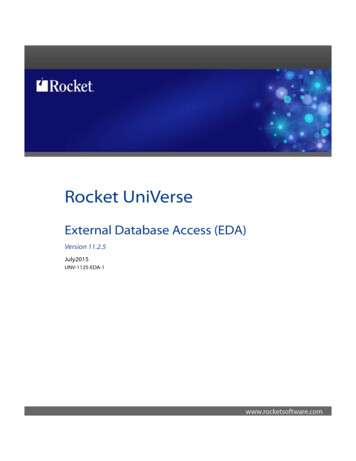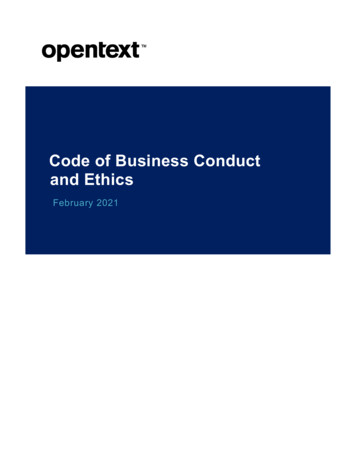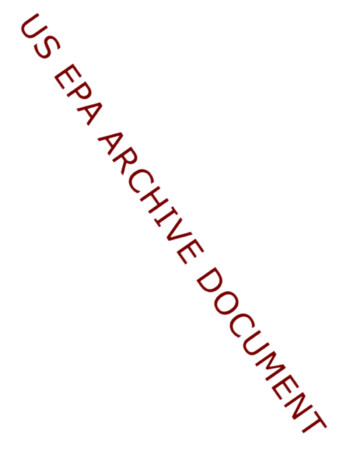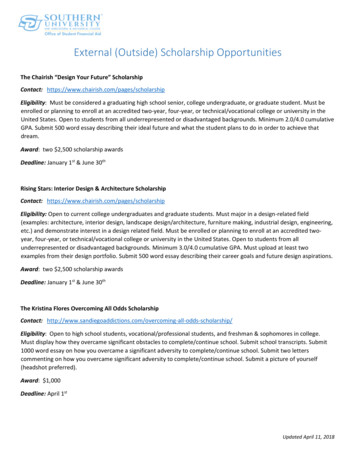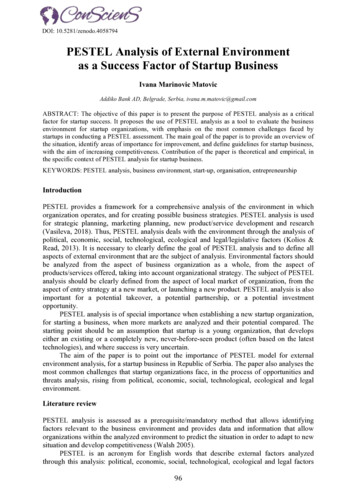
Transcription
DOI: 10.5281/zenodo.4058794PESTEL Analysis of External Environmentas a Success Factor of Startup BusinessIvana Marinovic MatovicAddiko Bank AD, Belgrade, Serbia, ivana.m.matovic@gmail.comABSTRACT: The objective of this paper is to present the purpose of PESTEL analysis as a criticalfactor for startup success. It proposes the use of PESTEL analysis as a tool to evaluate the businessenvironment for startup organizations, with emphasis on the most common challenges faced bystartups in conducting a PESTEL assessment. The main goal of the paper is to provide an overview ofthe situation, identify areas of importance for improvement, and define guidelines for startup business,with the aim of increasing competitiveness. Contribution of the paper is theoretical and empirical, inthe specific context of PESTEL analysis for startup business.KEYWORDS: PESTEL analysis, business environment, start-up, organisation, entrepreneurshipIntroductionPESTEL provides a framework for a comprehensive analysis of the environment in whichorganization operates, and for creating possible business strategies. PESTEL analysis is usedfor strategic planning, marketing planning, new product/service development and research(Vasileva, 2018). Thus, PESTEL analysis deals with the environment through the analysis ofpolitical, economic, social, technological, ecological and legal/legislative factors (Kolios &Read, 2013). It is necessary to clearly define the goal of PESTEL analysis and to define allaspects of external environment that are the subject of analysis. Environmental factors shouldbe analyzed from the aspect of business organization as a whole, from the aspect ofproducts/services offered, taking into account organizational strategy. The subject of PESTELanalysis should be clearly defined from the aspect of local market of organization, from theaspect of entry strategy at a new market, or launching a new product. PESTEL analysis is alsoimportant for a potential takeover, a potential partnership, or a potential investmentopportunity.PESTEL analysis is of special importance when establishing a new startup organization,for starting a business, when more markets are analyzed and their potential compared. Thestarting point should be an assumption that startup is a young organization, that developseither an existing or a completely new, never-before-seen product (often based on the latesttechnologies), and where success is very uncertain.The aim of the paper is to point out the importance of PESTEL model for externalenvironment analysis, for a startup business in Republic of Serbia. The paper also analyses themost common challenges that startup organizations face, in the process of opportunities andthreats analysis, rising from political, economic, social, technological, ecological and legalenvironment.Literature reviewPESTEL analysis is assessed as a prerequisite/mandatory method that allows identifyingfactors relevant to the business environment and provides data and information that alloworganizations within the analyzed environment to predict the situation in order to adapt to newsituation and develop competitiveness (Walsh 2005).PESTEL is an acronym for English words that describe external factors analyzedthrough this analysis: political, economic, social, technological, ecological and legal factors96
CONSCIENS CONFERENCE ON SCIENCE AND SOCIETYSeptember 28-29, 2020(Rastogi & Trivedi, 2016; Maksimovic et al., 2019). PESTEL analysis is one of the mostimportant and unavoidable tools for assessing external impacts that every organization mustapply, in order to analyze the situation and define guidelines and directions for improving anddeveloping a development strategy (Shtal et al., 2018). This method is most suitable forapplication to the overall business environment, and not to each individual organization of abusiness environment, because the factors that appear in this approach are conceived in thisway (Mack & Putzschel, 2014). In PESTEL analysis, the evaluation of factors is performedindividually, without evaluation of their interaction (Yuksel, 2012), so it is appropriate toapply PESTEL method in combination with some other methods from the domain ofengineering or IT methods and tools (Tsangas et al., 2019).PESTEL analysis is a tool used for analysis and monitoring of external environmentalfactors with an impact on the organization (Christodoulou & Cullinane 2019). PESTELanalysis enables identifying business opportunities and threats and adaptating to marketchanges in a timely manner. Indirectly, the results of PESTEL analysis indicate opportunitiesand threats, that are later addressed in SWOT analysis, as one of the basic tools for definingorganizational strategy. The key dimensions of the environment that are analyzed are (Kolios& Read, 2013):Political factors - When considering this aspect, priority should be given to answeringquestions related to the stability of the political situation in the market. After that, the impactof local laws and regulations on business, then business ethics, taxes, fees, customs and otherstate contributions that differ from state to state are considered. Besides, the labor law and itsfunctionality, market barriers, health issues, and tax policy should be considered in thisdomain.Economic factors - From the economic point of view, the impact on business should beobserved through the way of financing offered by banks, interest rates in individual countries,exchange rate, quality costs, inflation rate, price and quality of labor and energy. The overallroad infrastructure has a significant impact in this domain, such as the existence andproximity of highways, proximity and functionality of ports, airport and railway infrastructureand the like. Income factors per capita are most often considered as economic factors,although in some cases it is also considered as a part of social factors.Social factors - This set of factors has a very significant impact on the overallassessment. It is first necessary to give answers to the influence of the most basic socialfactors, such as: demographic structure, religious influence, national culture, level ofeducation, structure of education, and the like. In addition, these factors include the protectionand safety at work, life insurance, pension insurance and others.Technological factors - In today's business conditions, characterized by the intensiveuse and availability of IT tools, this area is of particular importance. Technological factorscannot be observed only at the level of availability of various technologies, but also in termsof the existence of infrastructure for the necessary support of modern systems. Through thisarea, most often considered are the following: level of technology development, innovation,amortization, level of equipment flexibility, automation level, technological motivation, rateof technological changes, technological development strategies, existence and functionality oftechnology parks, and the like.Ecological factors - When considering ecological factors, the most important are: thequality of human attitudes towards natural resources; biodiversity; recycling of raw materials;control and minimization of air, soil and water pollution. Sustainable business relations withothers (fair trade), as fair treatment of suppliers, employees, etc.Legal factors – The most often considered legal factors are: laws, regulatory agencies,requirements, regulations, standards, labor regulation, capital flow (foreign investment).97
CONSCIENS CONFERENCE ON SCIENCE AND SOCIETYSeptember 28-29, 2020The most common challenges of PESTEL analysis in startup organizationsAs with economic factors, startup organizations have a challenge when analysing the socialfactors within PESTEL. Insufficient depth of analysis leads to insufficiently good strategicdecisions, and missed business opportunities. Specific omissions relate to superficiallyanalyzed social trends, shopping priorities, demographic analysis (population, populationtrends, gender structure in the market in which it operates), which results in difficult salesplanning in long-term business projections.PESTEL analysis is one of the key elements in designing future business. Below wewill present some quality PESTEL analysis of environmental factors. Presented PESTELanalyzes were made by startup organizations, as part of their business plans, in the process ofpreparing feasibility studies for participation in the Entrepreneurship and Self-EmploymentPromotion Program1.Startup organization „A“ is engaged in the production of high quality cold-pressed oilfrom organically grown raw materials. The production range includes cold-pressed oils fromsunflower, corn, flax, pumpkin seeds and other oilseed plants, with the addition of herbs(peppers, mushrooms, garlic, tomatoes, basil, hot peppers and others). The product is intendedfor consumers who have a sophisticated taste, who, in addition to the product quality, requireenjoying in visual terms, so it has exclusive packaging. The product is intended for use inhotels and restaurants by incorporating a plastic dispenser under the bottle cap, whichprevents excessive oil spills and allows applying the oil to all serving types. In addition to thecold-pressed oil, the secondary product is oil cake, as a residue of the oil production process.The oil cake is an excellent source of protein in animal feed and is used as a proteincomponent in the production or preparation of animal feed.Table 1: An example of PESTEL analysis - Startup organization „A“Externalenvironmental factorsFactor(P) PoliticalFood productionregulations(E) EconomicCompetitionChanceThreatYES - Introducing stricter foodproduction regulations thatwould require technology changeYES – Competition, developed,strong and numerous - thefounder knows the competitionmethod, sales channels, volumes,assortment and quality of similarcompetition productsLocal marketYES - Knowledge of the local market and existingcustomer relationshipsSmall shopsYES - Special conditions for small specializedshops and tourist activitiesMarketYES – The market potential is 30.000 householdslocally, of which the estimated share is 0.5% (basedon knowledge of consumer needs from theconducted surveys)Livestock farmsYES – Oil cake sales directly to livestock farms (50farms in the surrounding area)YES - Traditional shops, HORECA1Entrepreneurship and Self-Employment Promotion Program is implemented by Public Investment Management Office, incooperation with the Development Fund of the Republic of Serbia and with the expert support of KFW(http://www.obnova.gov.rs/english)98
CONSCIENS CONFERENCE ON SCIENCE AND SOCIETYSales channelsLocationSeptember 28-29, 2020YES - Very convenient location in terms of rawmaterial availability,good conditions for own primary production of rawmaterialsYES - Possibility to apply for funds fordevelopment, capacity and quality improvementAvailability of EUfunds (IPARD)Plan:4,200 l oil8,300 kg oil cakesRevenue (1styear) 30,000 EURMargin 62%Seasonality (largestocks of rawmaterials forannualproduction)Tourism(S) Social(T) TechnologicalYES - The proximity and potential of touristfacilities, the ability to sell oils as souvenirs, hotelsand restaurantsUnemploymentYES - Possibility of employment benefits,availability of workforceNutrition trendsYES - Favorable trends in eating habits,Consumption of healthy, organic food, of vegetableorigin, Possibility to participate in promotionalcampaigns, marketing, sales promotionNewrevolutionarytechnologyRaw material basedevelopedNew standards forequipment andwaste disposal(E) Ecological(L) LegalNO - Hypothetical threat,unlikelyYES - Access to high quality raw materialsYES - Introducing stricterstandards that could increaseproduction costs and requireadditional investmentsWithoutsignificant impactSource: Author, based on Entrepreneurship and Self-Employment Promotion ProgramThe main activity of startup organization „B“ is retail sale of personal care products andhousehold chemicals. These products come from domestic manufacturers, primarily fromLOMAX Subotica, which has its regional distribution center in Niš. Product range is thefollowing: Personal care; Household chemicals, footwear care, insecticides; Exclusivecosmetic products. Future expansion would be based on exclusive cosmetic products fromforeign manufacturers: Gucci, Bvlgari, Armani, Dolce Gabbana, Prada, Versace, and others.Table 2: An example of PESTEL analysis - Startup organization „B“Externalenvironmental factors(P) Political(E) EconomicFactorChanceThreatPolitical stability, strategic determination of the Government of theRepublic of Serbia for the development of Niš regionYESYES - Change inpoliticalstructures,impact ontender, on publicsector buyersMarket - Niš150,000 families x 32,5 / month spending on “chemistry” 58,500,000/ year; according to experience and acquaintance, monthly sales areplanned for 400 families, which makes 0.26% of Niš marketYES - Lowerprices thancompetitors99
CONSCIENS CONFERENCE ON SCIENCE AND SOCIETYSeptember 28-29, 2020Lomax products and other chemistryDiscount sales (Retail)More favorable than others (due to deferred payment and rebate fromsupplier)Favorable population structure due to increasing employment (the influxof foreignersInvestment)On-line sales; WEB storeTechnical, sanitary and hygienic conditions for the store are fulfilledLaw on conditions for traffic ofgoods, performance of services, in goods traffic, andinspection(S) Social(T) Technological(E) Ecological(L) LegalYESYESYESYESSource: Author, based on Entrepreneurship and Self-Employment Promotion ProgramStartup organization „C“ operates in the field of tourism, travels organization in thecountry and abroad. It is located in Belgrade. The main activity is the organization of groupand individual travel, summer and winter vacations, European tours, distant destinations, aswell as the organization of student excursions and recreational classes, and summer languageschools around the world. It cooperates with a large number of travel agencies, tour operators,so the offer is very diverse. It deals with airline ticket sales, hotel and hostel reservationsworldwide through proven reservation systems. It plans to create short, content and affordablearrangements throughout the year, following the needs of clients and trends in world tourism(the most frequent trips of 3-5 days).Table 3: An example of PESTEL analysis - Startup organization „C“External environmentalfactors(P) Political(E) EconomicFactorChanceThreatLocal government decisionsYESNew interstate agreements inair trafficYESAccording to official data, there are 600,000 employees in Belgrade.Our target group is 150,000 clients who are „tourist active”. The planis to occupy 0.3% of the market for the next 5 years, ie. to have 450500 satisfied customers in our portfolioYESCompetition - 276 agencies, 190 of which are licensed in Belgrade.The average market share per agency is 0.5%.YES(S) Social(T) Technological(E) Ecological(L) LegalDeveloping an online business with a keypartners (for which we are qualified)New trends in tourism - more short trips, anti-stress programs againstmanagerial diseases, increasing tourist needs and increasingparticipation of touristsactivities in GDPDigitization of businessYESSoftware for searching the cheapest airline flightsInadequate maintenance of national parks; underinvestment inecologyChanges in tax regulations; Stricter consumer protection regulationYESStricter membership requirements for tourism associationsYESYESYESYESYESSource: Author, based on Entrepreneurship and Self-Employment Promotion ProgramConclusionsStartup organizations operate today in a dynamic and turbulent environment, the key focus ison understanding the state and changes in it. Within the external environment of theorganization, numerous factors are key to the survival of startup businesses in the market.100
CONSCIENS CONFERENCE ON SCIENCE AND SOCIETYSeptember 28-29, 2020There are many methods used in the analysis of the external environment, but the most widelyaccepted is PESTEL analysis, which relates the factors of the external environment, andanalyzes current and future opportunities and threats that may arise from the factors ofpolitical, economic, social, technological, ecological and legal nature. Management mustcontinually monitor macro environment of the organization, analyze threats and opportunitiesand adapt to the impacts of environmental factors. Management's response to environmentalinfluences may be the choice of an appropriate strategy, most relevant to organization at thatmoment. Quality analysis of macro-environmental factors, performed using PESTEL model,leads to success in using business opportunities, while a number of threats will be overcomeby finding business solutions that can counteract their negative impact.This paper presents PESTEL analysis of the macro environment on the example ofstartup organizations in the Republic of Serbia. Based on the research results, it can beconcluded that in the external environment of Serbian startup organizations, the opportunitiesare stronger than the threats, ie. that the external environment has an overall positive impacton the startup business. During the research, startup organizations in the Republic of Serbiarecognized four groups of factors as strategic threats: political, economic, ecological andlegal, while social and technological factors represent only opportunities for success anddevelopment in business. As political factors that pose a threat, startup organizations stated:Introducing stricter food production regulations that would require technology change;Change in political structures, impact on tender, on public sector buyers; Local governmentdecisions; New interstate agreements in air traffic. Economic factors pose a standard threat,such as: Competition, developed, strong and numerous. As ecological factors that cannegatively affect business, startup organizations listed: Introducing stricter standards thatcould increase production costs and require additional investments; Inadequate maintenanceof national parks; Underinvestment in ecology. Among the legal factors that can jeopardize astartup organization, the most significant are: Changes in tax regulations; Stricter consumerprotection regulation; Stricter membership requirements for tourism associations.With well-designed strategic management, the owners of startup organizations in theRepublic of Serbia should find ways to use the described opportunities to improve businessperformances. As research has found, there are a number of threats that should not be ignored.Threats from the external macro-environment need to be bridged by finding businesssolutions that can neutralize their negative impact.ReferencesChristodoulou, A., Cullinane, K. 2019. “Identifying the Main Opportunities and Challenges from theImplementation of a Port Energy Management System: A SWOT/PESTLE Analysis.” Sustainability11(21): 1-15.Kolios, A., Read, G. 2013. “A Political, Economic, Social, Technology, Legal and Environmental (PESTLE)Approach for Risk Identification of the Tidal Industry in the United Kingdom.” Energies 6(10): 50235045.Mack, J., Putzschel, J. 2014. The Influence of Contextual Factors on the Entrepreneurial Process, Umeå Schoolof Business and Economics, Master Thesis.Maksimovic, M., Pivac, T., Ivkov-Dzigurski, A., Kosic, K. 2019. “About marketing strategy for wine route,Case study – Constantinople wine route,.” 4th International Thematic Monograph - Modern ManagementTools and Economy of Tourism Sector in Present Era, Belgrade, 685-695.Pourmohammadi, K., Bastani, P., Shojaei, P. 2020. “A comprehensive environmental scanning and strategicanalysis of Iranian Public Hospitals: a prospective approach.” BMC Res Notes, 13, 179.Rastogi, N., Trivedi, M.K. 2016. “Pestle Technique – A Tool to Identify External Risks in ConstructionProjects,.” International Research Journal of Engineering and Technology 3(1): 384-388.Shtal, T.V., Buriak, M.M., Amirbekuly, Y., Ukubassova, G.S., Kaskin, T.T., Toiboldinova, Z.G. 2018.“Methods of analysis of the external environment of business activities.” Revista Espacios 39(12): 1-22.101
CONSCIENS CONFERENCE ON SCIENCE AND SOCIETYSeptember 28-29, 2020Tsangas, M., Jeguirim, M., Limousy, L., Zorpas, A. 2019. “The Application of Analytical Hierarchy Process inCombination with PESTEL-SWOT Analysis to Assess the Hydrocarbons Sector in Cyprus.” Energies12(5): 1-17.Vasileva, E. 2018. “Application of the Pest Analysis for Strategic Planning of Regional Development.” 49thInternational Scientific Conference Quantitative and Qualitative Analysis in Economics, EconomicFaculty in Nis, 223-229.Walsh, P. 2005. “Dealing with the uncertainties of environmental change by adding scenario planning to thestrategy reformulation equation,.” Management Decision 43(1): 113-122.Yuksel, I. 2012. “Developing a Multi-Criteria Decision Making Model for PESTEL Analysis.” InternationalJournal of Business and Management 7(24): 52-66.102
PESTEL analysis is a tool used for analysis and monitoring of external environmental factors with an impact on the organization (Christodoulou & Cullinane 2019). PESTEL analysis enables identifying business opportun
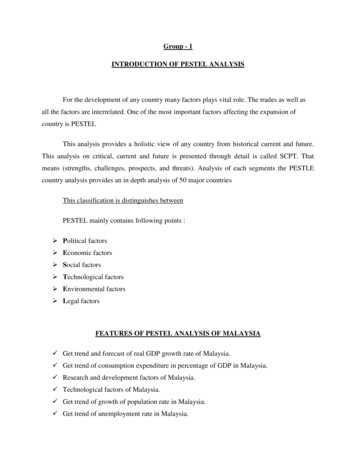
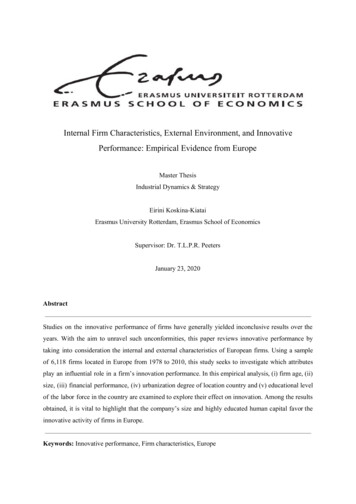
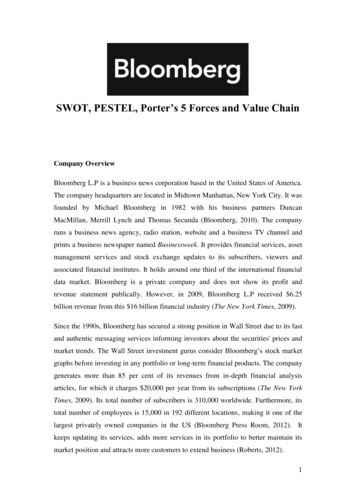
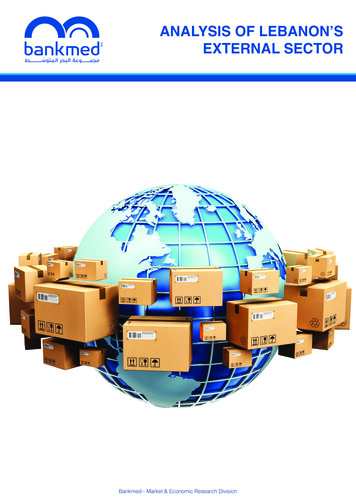

![03[1] Analysis of the Internal Environment](/img/2/031-analysis-of-the-internal-environment.jpg)


